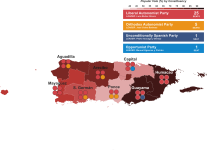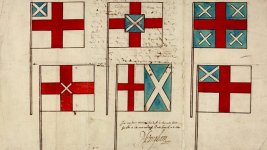The way Andrew Teale does it for multi-member bloc vote wards in English local elections, which is what I have adopted, is as follows:
See here for an example:
https://www.andrewteale.me.uk/leap/results/2014/23/ Take the first case, Addiscombe. Here there was a full slate of 3 candidates for the Conservatives, Labour, Lib Dems and Greens, but only one UKIP candidate. Summing all the votes for all the Conservative candidates and calling that the Conservative vote would be misleading, because it would imply UKIP were behind the Greens rather than coming closer than them to winning a seat. So what Andrew does is to count only the votes for the leading candidate of every party and then create party percentages from (Leading Labour Candidate's Votes / All Leading Candidates' Votes) * 100 and so on. I then use the resulting percentages to create percentage shading maps.
I can't remember what he does with independents but I tend to treat them as though they were a slate, even though this isn't always true, as otherwise it misleadingly inflates their votes.
Thanks for this! It was indeed useful, but before I show how it worked out on the 1898 map, let me show another 1898 map.
In November 1897, the Spanish authorities granted Cuba and Puerto Rico their respective Statutes of Autonomy to the two Antillean islands. These Charters granted the two islands wide-ranging autonomy on all matters except foreign affairs and defence (notably, tariff-setting and management were ceded to the island governments - this was an important issue given the depth of the trade network with the US).
These charters essentially enshrined a very similar model of governance in the island as it existed - formally - in the Peninsula. Each island would have a bicameral Parliament, formed by two chambers, the directly-elected Chamber of Representatives (lower house) and the upper house, the Council of Administration (part indirectly elected, part appointed by the Governor-General) and an executive that, while technically headed by a Governor-General appointed by Madrid (the first and sole holder would be Lieutenant-General Manuel Macías Casado), in practice would be run by a Cabinet responsible to the Chambers.
In the case of Puerto Rico, its Statute provided for a lower house of 32 members elected from 8 4-member constituencies using the same system used in the constituencies for the Spanish election, a system of limited multiple non-cumulative voting, where each voter was entitled to cast three votes for different candidates. The Charter, paired with the extension of universal male suffrage (as enshrined in the 1890 law for the Peninsula) to the islands, was part of the reform agenda to meet the demands of autonomists in the difficult situation Spain faced vis-à-vis the Cuban insurrection and growing American hostility.
The granting of autonomy wrecked the power of the previously almighty Unconditionally Spanish Party, which had already been wrecked by splits between its more conservative and more liberal wings. The latter left to form an Unconditionally Spanish Left party that would later rename itself the 'Opportunist Party'. While hailing from the same social classes, the Opportunist Party was not (as) opposed to Antillean autonomy.
After autonomy was introduced (by decree, and illegally, I might add - it later required the Sagasta cabinet to pass a law exempting itself from responsibility for the unconstitutional action), a new cabinet was immediately formed by figures from the autonomist movement. At this point, the autonomist movement had managed to coalesce - with some difficulty - into a single party, the Liberal Autonomist Union. However, differences in forming the slates of candidates (and specifically the opposition of Muñoz Rivera and his followers to include Celso Barbosa in the slate for the capital' constituency) just days before the election broke the party. This had come on top of the formal alignment of the Autonomists with the Liberals in Madrid, which did not sit well with the republican elements in the party.
As a result, the two old factions of the autonomist movement—monarchist, liberal-aligned, and republican (but not pro-independence)—broke into a fairly chaotic situation days before the elections in late March 1898. The different newspapers around the election speak of deals made between the 'Orthodox' or 'Historic' Autonomists and the Opportunists in the capital. At the same time, the Liberal Autonomists were accused of practising the same kind of coactive vote-gathering methods that were so common in the Restauración Spain.
The Chamber formally met for the first time on 21 April 1898, the same day the US declared war on Spain. And the rest, as they say, is history.













